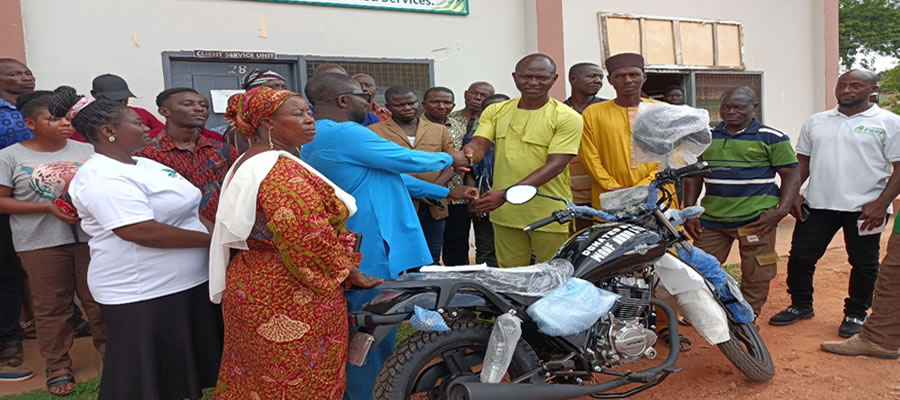

Sources of Household Incomes
One basic indicator of standard of living of people is the level of income as well as expenditure pattern. It is believed that the higher the income level the higher the standard of living and vice versa. The various household incomes are generated from sources such as agriculture, service, commerce and industry.
Agriculture
The District has extensive fertile land coupled with favourable climatic conditions. Due to these factors, agriculture has been and continues to be the main economic venture in the district. It employs about 72.7% of the workforce and contributes about 60% of household incomes. Agriculture in the district is undertaken at a subsistence level. Only a few of the farmers are engaged in plantation and mechanized farming. The rainfall is bi-modal and supports the cultivation of maize in two seasons (April-June) and (July-September).
The major crops cultivated include the following; yam, cassava, millet and sorghum, cowpea, rice, groundnut, watermelon, cashew, mango and tobacco. Vegetable farming has also taken root with the leading crop being tomato followed by garden eggs. To achieve a sustainable district development, it is pertinent that the industrial sector is improved to add value to the agricultural produce. The NBSSI and other collaborating agencies need to step-up their efforts at facilitating the setting up of (small scale) industries in the district.
Livestock activities are also being carried out in the district. In this sector, there is appreciable number of cattle, sheep, goats, and pigs, local and improved poultry. Despite the important role played by Agriculture in the District, there are few extension officers in the district. The major agriculture production centers in the district are: Apesika, Amoma, Ayima, Jema, Ntankoro, Pamdu, Nante and Kokuma.
The private sector serves as an engine of growth of an economy if its capacity is enhanced and well strengthened. This was the focus of the District Medium Term Development Plan 2002-2005. The priorities for private sector competitiveness as one of the three (3) pillars of the GPRS II, which places more emphasis on modernized agriculture, trade and industry, transport, energy, ICT and Mining.
Agriculture in the Local Economy
Agriculture plays a very important role in the district’s economy. This assertion is seen in the number of people who are engaged in the industry as on table showing the District Employment Structure. However as can be seen from this study and in other literature the bulk of the people engaged in agriculture are poor.
Land Issues
Like most places in Ghana, land is mainly owned by the traditional authorities, i.e. Chiefs, who hold it in trust for their people. Such lands are known as stool lands. The second category of land is those owned by various families or clans within the District. Such lands known as family lands are managed by he heads of the families that own them. The third category of lands is those acquired in the interest of the public for various purposes. Notable of such lands vested in the Government by enactment include, right of way of all highway and feeder roads, school lands, health facilities and all other lands on which public buildings are sited.
Farming Systems
The various farming systems / methods practiced by the farmers in the district include; shifting cultivation, continuous cropping, mixed cropping, mono cropping, inter cropping, and land rotation and bush fallows. The major crops cultivated include yam, cassava, cocoyam, rice, potato, pepper, plantain, garden eggs, okro, watermelon, ground nut cowpea, and other tree crops such as cashew, mango.
There are also non-traditional farming activities that are being practiced by the farmers. These include grascutter rearing, bee-keeping.
Small size of farm Holdings
An estimated 80% of all farms are below one hectare. The underlying cause of which is the land tenure system. Land belongs to families and is shared amongst family members. This makes it difficult for one to access large holdings for mechanised farming. This is not to under estimate the presence of farm mechanisation services providers, but then this means increased overhead cost per hectare of land under mechanised agriculture. Only about 7.5% of farms are above five (5) hectares. Table 1.8 shows the area cropped in hectares and yield per tonnage of the district.
High cost of labour for Agriculture
The District’s Agriculture is basically rain fed, hence demand for labour is at about the same time for all farmers. This leads to a high demand for labour at land preparation, planting, weed control, harvesting, etc. The DADU has to introduce new technologies such as zero tillage mucuna demonstrations to reduce the demand for labour.
High cost of agricultural inputs
Following the adoption of the Structural Adjustment Programme (SAP) in the 1990s, Government gradually removed all forms of subsidy on Agricultural inputs. This policy has pushed the prices of inputs, such as fertilizers, pesticides and equipment beyond the reach of poor farmers. Hence the use of inputs appears to be limited to high valued vegetable crops, such as tomatoes, cabbage, carrots, etc. This also compels farmers to use hazardous agro-chemicals, which have been banned in most communities, but smuggled and sold cheaply to unsuspecting and illiterate farmers, leading to misuse of agro-chemicals and high incidence of pests and diseases.
High incidences of Pest and Diseases
Partly as a result of the development of resistance and partly as a result of the improper use of pesticides, there is an increasing incidence of pest and diseases. Whilst the use of pesticides in conventional agriculture usually leads to higher yields, the practise of Integrated Pest Management (IPM) is a more sustainable approach and the DADU in collaboration with some NGOs should promote organic farming in the District.
Low Impact of Agricultural Extension
Agricultural extension is the engine of growth of the Agricultural sector, as it sets out to carry out demonstrations of the latest production technologies to farmers. Incidentally, the ratio of Agricultural Extension Agents to farmers is very low in the range of 1:1000 farmers. Given this situation, the use of demonstrations and organisation of field days and study tours is very important. Incidentally, the Ministry of Food & Agriculture in the newly created Kintampo South District has acute shortage of personnel.
Consequently, demonstrations have been curtailed. Given the level of illiteracy of the majority of farmers, the only viable means of empowering farmers to adopt the production techniques is to establish farmer field schools and carry out demonstrations and study tours for farmers to have a first hand information on modern agriculture.
Poor Infrastructure
The impact of agriculture in the district will be greater, if food-producing areas are linked to consuming urban centres at lower cost. It is estimated that transportation and handling alone may constitute up to 70% of the cost of some food produce. Most areas with fertile farmlands lack basic infrastructure of potable water and access roads. This leads to over exploitation of farmers by market queens.
Lack of Irrigation Facilities.
Irrigation facilities, if provided, would also increase the opportunities available to farmers to produce all year round. Fortunately the Kintampo South District has significant water resources, which could be used for irrigation for example Nante. The District Directorate of Agriculture itself has serious problems with a means of transport of an over aged official vehicle and motorcycles which have high maintenance cost. There is also no mobile clinic for animal health delivery services.
Date Created : 11/17/2017 1:50:11 AM











 facebook
facebook
 twitter
twitter
 Youtube
Youtube
 +233 593 831 280
+233 593 831 280 0800 430 430
0800 430 430 GPS: GE-231-4383
GPS: GE-231-4383 info@ghanadistricts.com
info@ghanadistricts.com Box GP1044, Accra, Ghana
Box GP1044, Accra, Ghana